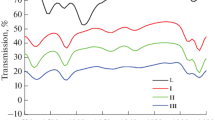Summary.
Iron (II) complexes with substituted tris(pyrazolyl) ligands, which exhibit a thermally driven transition from a low-spin state at low temperatures to a high-spin state at elevated temperatures, have been studied by Mössbauer spectroscopy and magnetic susceptibility measurements. From the observed spectra the molar high-spin fraction and the transition temperature have been extracted. All substituents, except for bromine, lead to a decrease of the transition temperature. Density functional calculations have been carried out to compare the experimentally observed shifts of the transition temperature with those derived from theory.
Similar content being viewed by others
Author information
Authors and Affiliations
Additional information
Corresponding author. E-mail: paulsen@physik.uni-luebeck.de
Received June 26, 2002; accepted July 22, 2002
Rights and permissions
About this article
Cite this article
Paulsen, H., Duelund, L., Zimmermann, A. et al. Substituent Effects on the Spin-Transition Temperature in Complexes with Tris(pyrazolyl) Ligands. Monatshefte für Chemie 134, 295–306 (2003). https://doi.org/10.1007/s00706-002-0522-7
Issue Date:
DOI: https://doi.org/10.1007/s00706-002-0522-7



